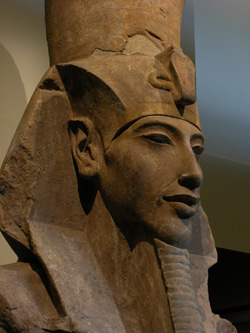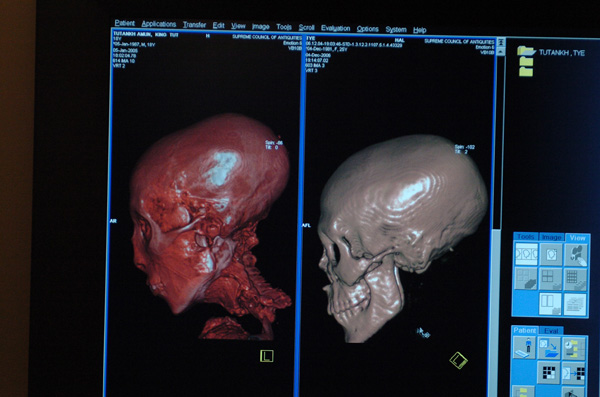|
Mystery of
the Mummy from KV55
The Valley of the Kings, on the west bank of the Nile across from the ancient city of Thebes, is famous as the final resting place of the pharaohs of the New Kingdom — Egypt’s “Golden Age.” There are 63 known tombs in the valley, of which 26 belonged to kings. Beginning with the great female pharaoh Hatshepsut, or perhaps her father Thutmose I, almost all of the rulers of the eighteenth, nineteenth and twentieth dynasties built their tombs in this silent valley. Only one king from this period, Amenhotep IV or Akhenaten, is known to have chosen a different burial site. Akhenaten rejected the worship of Amun, the principal state god of his forefathers, in favor of the sun disk, the Aten. He abandoned Thebes, then the religious capital of Egypt, and moved his government to a virgin site in Middle Egypt known today as El-Amarna; it was near this new capital city that he had his final resting place prepared. Akhenaten’s tomb is similar in some ways to those built in the Valley of the Kings; it consists of a number of chambers and passages cut deep into the limestone cliffs of a remote valley. It is decorated, however, with unique scenes connected with the worship of the sun-god Aten, and with images of the royal family. Akhenaten’s beautiful wife, Queen Nefertiti, figures prominently in his tomb decorations, as in much of the art of the Amarna period. Although Akhenaten’s tomb at El-Amarna was never completely finished, there is little doubt that the king was buried there. After Akhenaten’s death,
Egypt returned to the worship of the old gods, and the name and image of
Akhenaten were erased from his monuments in an effort to wipe out the
memory of his ‘heretical’ reign. A flight of 21 stairs leads down to the entrance, which Ayrton found blocked with limestone. Although the blocking may have been opened and then resealed in ancient times, the excavators found that it was still stamped with the necropolis seal, a jackal atop nine bows representing the traditional enemies of Egypt. Beyond the entrance lay a corridor, partially filled with pieces of limestone, leading to a rectangular burial chamber containing a gilded and inlaid wooden coffin. Inside this coffin rested a badly decayed mummy, which had been reduced to little more than a skeleton. The lower three quarters of the coffin’s gilded mask had been ripped away and the cartouches (oval rings containing royal names) that once identified the owner were removed, leaving the remains inside both faceless and nameless. The identity of the mummy found in KV55 is one of Egyptology’s most enduring mysteries.
The contents of KV55 offer some clues to who the mystery mummy might have been. Although the tomb had been badly damaged over the centuries by floods that periodically inundate the Valley of the Kings, many intriguing artifacts were found inside. Apart from the coffin containing the mysterious mummy, the most spectacular objects were panels from a gilded wooden shrine that had been built to protect the sarcophagus of Queen Tiye, the mother of Akhenaten. Originally, the shrine had borne the name and image of Akhenaten along with that of the queen, but these were erased in ancient times. Other objects from KV55 included small clay sealings bearing the name of Tiye’s husband Amenhotep III, and Tutankhamun, who may have been her grandson. There were also vessels of stone, glass and pottery, along with a few pieces of jewelry, inscribed with the names of Tiye, Amenhotep III and one of Amenhotep III’s daughters, Princess Sitamun. Four ‘magical bricks’ made of mud were also found in the tomb, stamped with the name of Akhenaten himself. A beautiful set of calcite canopic jars made for Akhenaten’s secondary wife Kiya rested in a niche carved into the southern wall of the burial chamber.
The presence of artifacts belonging to members of the royal family of El-Amarna led to the tomb being dubbed the “Amarna Cache.” Most people think that KV55 was in fact used for the reburial of a mummy and funerary equipment that had originally been interred in a royal tomb or tombs at El-Amarna. Unfortunately, it is impossible to determine which of the many names found on the objects in the tomb belonged to the skeletal remains found in the gilded wooden coffin. The cartouches on the coffin
might once have held the key to the identity of the KV55 mummy. Even
without them, however, many scholars have felt that the remaining
inscriptions, which include titles and epithets, might reveal the identity
of the coffin’s owner. The great linguist Sir Alan Gardiner argued that
the titles showed that the coffin had been made for Akhenaten, and that no
one else could have been buried in it. Other scholars, however, have noted
that the inscriptions were altered at some point, and it has been
suggested that the coffin’s occupant might not be its original owner. The
French scholar Georges Daressy thought that it might originally have been
made for Queen Tiye, and then altered for Smenkhkare, a mysterious
successor of Akhenaten who ruled Egypt for only a short time. Another
possibility is that it was made for Smenkhkare during a time when he and
Akhenaten ruled together as pharaohs, and then altered when he took the
throne as sole ruler. Gardiner’s claim that the
inscriptions on the coffin could only have referred to Akhenaten, together
with the presence of the ‘heretic’ pharaoh’s name on other artifacts in
KV55, convinced many scholars that this mysterious king had been brought
to Thebes for reburial after his original tomb at El-Amarna was
desecrated. The bones belong to a male, with a highly elongated skull.
This trait is found in artistic representations of Akhenaten and his
family, and can also be seen in the mummy of Tutankhamun, who may have
been Akhenaten’s son. In addition, the KV55 mummy shares a blood type with
the golden king; studies have indicated that the remains from the Amarna
Cache belonged to an individual closely related to Tutankhamun. Taken
together, the clues lead to the seemingly inevitable conclusion that the
KV55 mummy is Akhenaten.
When we brought the remains
from KV 55 out, it was the first time that I had actually seen them. It
was immediately clear to me that the skull and the other bones are in very
bad condition. Dr. Hani Abdel Rahman operated the equipment, and our
gifted radiologist Dr. Ashraf Selim worked with us to interpret the
results.
Akhenaten, Nefertiti and the Amarna period have received a great deal of attention in recent years. One of the main reasons for this continued interest is that I have requested the loan to Egypt of the head of Nefertiti in the collection of the Egyptian Museum in Berlin. So far, the Berlin museum has not agreed to our request to bring the head to Egypt for three months as part of an exhibition to celebrate the opening in 2010 of the Akhenaten Museum in Minya. I do believe that Egypt’s people have the right to see this beautiful sculpture — a vital part of their heritage and identity — in person. In the meantime, the wonderful artifacts in the newly renovated Amarna room at the Egyptian Museum in Cairo are reminders of the achievements of this period. The shrine of Queen Tiye and the lid of the coffin from KV55 adorn this gallery. A quartzite bust of Nefertiti, perhaps even more beautiful than the painted limestone bust in Berlin, also offers a glimpse of the splendor of the Amarna age. You can also see the gold foil and inlay from the bottom part of the KV55 coffin, mounted on a plexiglass base to show how they were arranged on the original coffin. My friend Mark Linz, the head
of the American University in Cairo Press, told me that he felt that the
renovated Amarna room is amazing and unique, adding that he hopes that it
will bring the glory of the Amarna period to life and tell people the
story of Akhenaten, the first king to believe in a single god. We will also embark on the first archaeological expedition in the valley ever to be conducted by an all-Egyptian team. It seems unbelievable that up to this point, every excavation in the Valley of the Kings has been the work of foreign scholars. We are working right now to the north of the tomb of Merenptah, the son and successor of Ramesses II. I truly believe that the tomb of Ramesses VIII may be located in this area. It is possible that even as you read this article, you will hear the announcement of a major discovery in the valley. There are still more royal
tombs yet undiscovered. The tomb of Amenhotep I, for example, is unknown,
although it may lie in the area of Deir el-Bahri. There are also many
mummies that have never been identified: The remains of Nefertiti,
Tutankhamun’s wife Ankhsenamun and many others may still await discovery
or identification. |
 Akhenaten,
Egypt’s first and only monotheistic Pharaoh, has intrigued Egyptologists
for centuries. Has the Egyptian Mummy Project finally found his mummy?
Akhenaten,
Egypt’s first and only monotheistic Pharaoh, has intrigued Egyptologists
for centuries. Has the Egyptian Mummy Project finally found his mummy?


